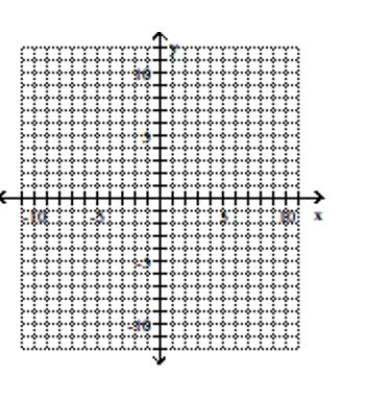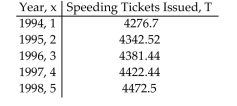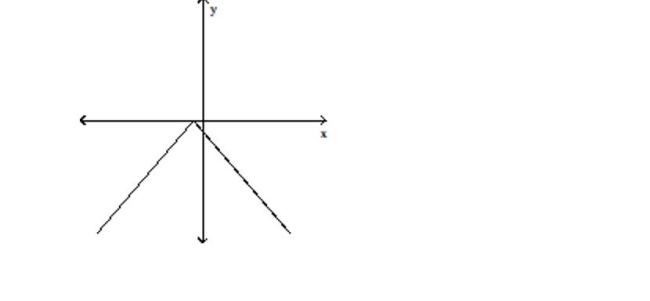A) The moose population in the refuge will grow out of control.
B) The moose population in the refuge will reach a constant amount greater than 0 .
C) The moose population in the refuge will be displaced by "oil" wells.
D) The moose population in the refuge will die out.
Correct Answer

verified
Correct Answer
verified
Multiple Choice
Determine whether the graph of the polynomial has y-axis symmetry, origin symmetry, or neither. -
A) -axis symmetry
B) origin symmetry
C) neither
Correct Answer

verified
Correct Answer
verified
Multiple Choice
Find the coordinates of the vertex for the parabola defined by the given quadratic function. -
A)
B)
C)
D)
Correct Answer

verified
Correct Answer
verified
Multiple Choice
Determine whether the graph of the polynomial has y-axis symmetry, origin symmetry, or neither. -
A) -axis symmetry
B) origin symmetry
C) neither
Correct Answer

verified
Correct Answer
verified
Multiple Choice
Find the x-intercepts of the polynomial function. State whether the graph crosses the x-axis, or touches the x-axis and turns around, at each intercept. -
A) 0 , touches the -axis and turns around;
4 , crosses the -axis
B) 0 , touches the -axis and turns around;
, crosses the -axis;
, crosses the x-axis;
1, crosses the x-axis;
C) 0 , touches the -axis and turns around;
, crosses the -axis
D) 0 , touches the -axis and turns around;
, crosses the -axis;
, touches the -axis and turns around
Correct Answer

verified
Correct Answer
verified
Multiple Choice
Use the vertex and intercepts to sketch the graph of the quadratic function.
-

A) ![]()
B) ![]()
C) ![]()
D) ![]()
Correct Answer

verified
Correct Answer
verified
Multiple Choice
Determine whether the graph of the polynomial has y-axis symmetry, origin symmetry, or neither. -
A) y-axis symmetry
B) origin symmetry
C) neither
Correct Answer

verified
Correct Answer
verified
Multiple Choice
Find the x-intercepts (if any) for the graph of the quadratic function. -
A) and
B) No x-intercepts
C) and
D) and
Correct Answer

verified
Correct Answer
verified
Multiple Choice
Find the x-intercepts of the polynomial function. State whether the graph crosses the x-axis, or touches the x-axis and turns around, at each intercept. -
A) 0 , touches the -axis and turns around;
6 , crosses the -axis
B) 0 , crosses the -axis;
, crosses the -axis;
, crosses the -axis
C) 0 , touches the -axis and turns around;
6 , touches the -axis and turns around
D) 0 , touches the -axis and turns around;
, crosses the -axis;
, crosses the -axis
Correct Answer

verified
Correct Answer
verified
Multiple Choice
Find the axis of symmetry of the parabola defined by the given quadratic function. -
A)
B)
C)
D)
Correct Answer

verified
Correct Answer
verified
Multiple Choice
Solve the problem
-The following table shows the number of speeding tickets issued in a county for the years 1994-1998, where 1 represents 1995, and so on.
 This data can be approximated using the third-degree polynomial
Use the Leading Coefficient Test to determine the end behavior to the right for the graph of T. Will this function be useful in modeling the number of speeding tickets issued over an extended period of time? Explain your answer.
This data can be approximated using the third-degree polynomial
Use the Leading Coefficient Test to determine the end behavior to the right for the graph of T. Will this function be useful in modeling the number of speeding tickets issued over an extended period of time? Explain your answer.
A) The graph of T decreases without bound to the right. Since the number of larceny thefts will eventually decrease, the function T will be useful in modeling the number of speeding tickets issued over an extended period of time.
B) The graph of T decreases without bound to the right. This means that as increases, the values of will become more and more negative and the function will no longer model the number of speeding tickets issued.
C) The graph of increases without bound to the right. This means that as increases, the values of will become large and positive and, since the values of T will become so large, the function will no longer model the number of speeding tickets issued.
D) The graph of approaches zero for large values of . This means that will not be useful in modeling the number of speeding tickets issued over an extended period.
Correct Answer

verified
Correct Answer
verified
Multiple Choice
Determine whether the given quadratic function has a minimum value or maximum value. Then find the coordinates of the minimum or maximum point. -
A) maximum;
B) minimum;
C) maximum;
D) minimum;
Correct Answer

verified
Correct Answer
verified
Multiple Choice
Determine the maximum possible number of turning points for the graph of the function. -
A) 1
B) 7
C) 3
D) 8
Correct Answer

verified
Correct Answer
verified
Multiple Choice
Find the range of the quadratic function. -
A)
B)
C)
D)
Correct Answer

verified
Correct Answer
verified
Multiple Choice
Find the range of the quadratic function. -
A)
B)
C)
D)
Correct Answer

verified
Correct Answer
verified
Multiple Choice
Use the Leading Coefficient Test to determine the end behavior of the polynomial function. Then use this end behavior to match the function with its graph. -
A) falls to the left and rises to the right![]()
B) rises to the left and falls to the right![]()
C) falls to the left and falls to the right![]()
D) rises to the left and rises to the right![]()
Correct Answer

verified
Correct Answer
verified
Multiple Choice
Find the x-intercepts of the polynomial function. State whether the graph crosses the x-axis, or touches the x-axis and turns around, at each intercept. -
A) 0 , touches the -axis and turns around;
5 , crosses the -axis;
, crosses the -axis
B) 0 , touches the -axis and turns around;
5 , touches the -axis and turns around;
, touches the -axis and turns around
C) 0 , crosses the -axis;
, crosses the -axis;
2 , crosses the -axis
D) 0 , touches the -axis and turns around;
, crosses the -axis;
2 , crosses the -axis
Correct Answer

verified
Correct Answer
verified
Multiple Choice
Determine whether the graph shown is the graph of a polynomial function.
-
A) not a polynomial function
B) polynomial function
Correct Answer

verified
Correct Answer
verified
Multiple Choice
Determine whether the given quadratic function has a minimum value or maximum value. Then find the coordinates of the minimum or maximum point. -
A) minimum;
B) minimum;
C) maximum;
D) maximum;
Correct Answer

verified
Correct Answer
verified
Multiple Choice
Find the axis of symmetry of the parabola defined by the given quadratic function. -
A)
B)
C)
D)
Correct Answer

verified
Correct Answer
verified
Showing 181 - 200 of 224